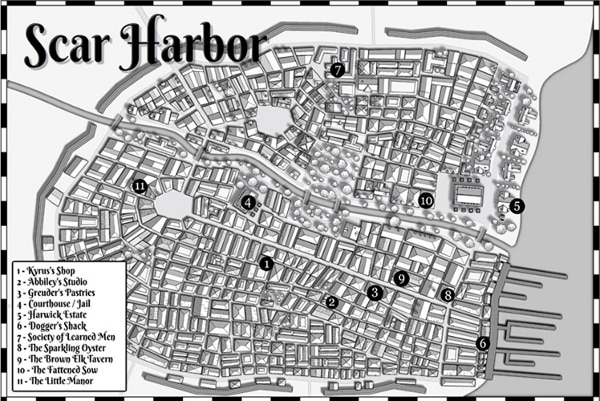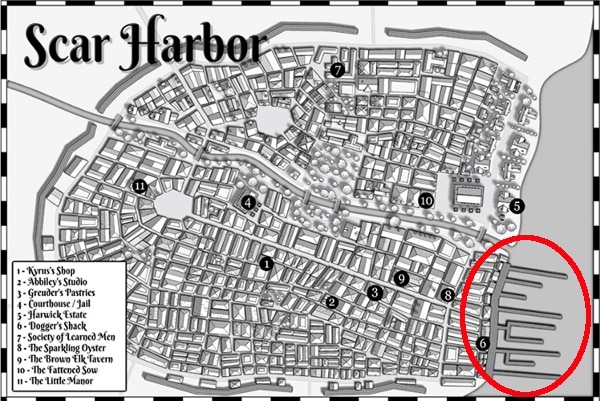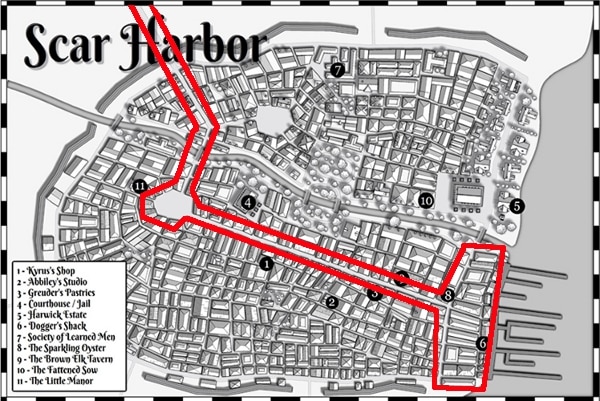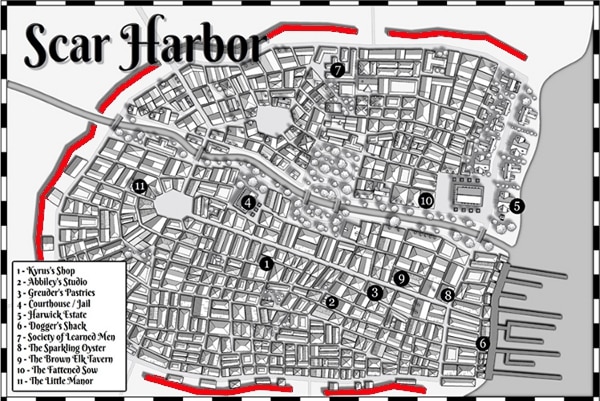In my earlier blog on Amateur Cartography, I covered the basic concepts behind how to draw a map to go along with your fantasy story. Mainly I focused on what ought to be included, what readers expect to be included, and how to go about conceptualizing the map from either a top-down or a bottom-up approach.
All that is going to apply here as I talk about city mapping. City mapping serves the same ends as mapping a kingdom or a continent: you are laying a geographical framework for your readers. However, there are some things to consider when mapping a city to make sure you have a city your readers will believe in. For this exercise I will be using the map of Scar Harbor that will be included in Aethersmith as an example.

Scar Harbor: Home of Kyrus Hinterdale
Why is there a city here?
Well, that’s a fair question now, isn’t it? Intelligent creatures, be they human or otherwise, have reasons for where they live. If they’ve chosen to settle down and build a city, there must be something special about the spot they chose. The two biggest factors are food and fresh water; you need both or you’re not going to have much of a population. Secondary factors are resources, trade, and security. Scar Harbor is built at the mouth of a river, where it empties into the Katamic Sea. The sea and the surrounding farmland provide food for the citizens and allow a city to exist there. The reason for Scar Harbor though is the port.

The deep water port is why Scar Harbor is a thriving city and not a fishing village
How did it evolve?
Cities are like living things: they grow from a tiny collection of buildings into an intricate webwork of streets and buildings. Figuring out how a city would have grown can give you an idea of what it ought to look like. Decide what would have been built first when the city was founded. Was it originally a fortified outpost? Maybe It should center around a keep. Was it a fishing village? The wharfs would be the city’s roots. Was the city build up from an inn that sat on a major crossroads? Maybe your city build up around that crossroads until one day a city held it in its grasp like a fist.
Scar Harbor has always been a fishing and trading city, first up and down the Growling River and then on to sea trade with distant lands.
What does a city need?
Houses and shops all look the same from a map view, within reason. You can either sketch them in or leave the city with a street-level map and allow the reader to assume that buildings fill in along the streets. But there is more to a city than just residential and commercial space (and you Sim City players can cool it, this is a fantasy map, so Industrial areas are strictly optional, except possibly for dwarfs). You need civic buildings, marketplaces, parks, monuments, historic sites, entertainment, etc. Not every city needs all of these, but an writer/cartographer should consider the character of the city they are creating and construct it accordingly. While I joked about the Sim City comparison, there is an element of that at work. Where the game is trying to simulate a city, you are trying to create a believable one from scratch.

Goods from the harbor filter up the main road through town and out via the road to Golis, the capital city of Acardia
If you want a free-thinking city, make sure there are museums, opera houses, theaters, universities. If you want to portray an oppressive land, have the city walled into districts with gatehouses protecting the crossings, with a courthouse and prison in each.
Defenses
It’s a fact of life that many a city will find the need to defend itself. Give some thought to the fortifications that the populace would have constructed. In a war-torn area these may be partially destroyed or constantly under construction for either repairs or improvements. A city under only the threat of war may have vast and elaborate defenses that have never been tested. A peaceful or complacent city may have little or no defenses worth noting.
Scar Harbor is an old city, built during a time when warfare often involved sieges and when the best defense for a city was a good wall. In modern times (as far as the Twinborn Trilogy is concerned), the age of the siege is past. Peace and the development of the cannon has led the city of Scar Harbor to abandon the wall as their primary defense. Now the Acardian Navy keeps the seas clear of invaders before they ever reach shore.

Living near the wall gives a feeling of that old world charm (or says that you couldn’t afford to buy riverfront property)
Reminder
It’s a map. It has two basic purposes in your book: to inform the reader about the places they are visiting in your work and to look beautiful. Both should enrich the reading experience.

Loving the maps!
Excellent food for thought when designing a city – wow but a LOT of work goes into writing fantasy, does it not?
If you write a story about New York, everyone has a picture in their head of New York. If you write a story about a place called Scar Harbor, you’ve got to create that picture for them. As a writer, you may not need to get into minute detail describing the city, its government, history, etc., but you do need to include enough that the reader can picture it. Adding a map is something you don’t need for every city (certainly not, since most books don’t include city maps at all), but you need the reader to believe the place exists.
The belief in the existence of your setting is the primary concern of world-building. World-building is really what sets sci-fi and fantasy apart from non-speculative fiction.